Can you really achieve yields advertised by cannabis seed banks?
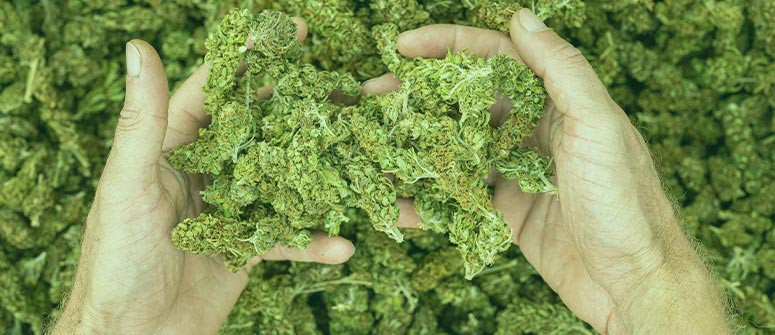
Cannabis breeders and seed banks often like to advertise their seeds as being able to produce plants that offer insane yields. Here, we look into whether these numbers are accurate, how such figures are determined, and, if it's possible, how to achieve said yields indoors and outdoors.
Contents:
When choosing cannabis seeds, one of the main things growers look for is yield potential. The cannabis industry is rife with online seed banks advertising weed seeds capable of producing monstrous amounts of cannabis flower. However, when harvest time comes around, actual yields often come in way beneath what customers are led to believe.
There are many, many factors that determine the final harvest weight from a cannabis grow. From genetics, to lights, to time spent in the vegetative stage, and much more, it’s not possible to accurately predict a yield before a grow.
Some seed banks inflate their numbers, to the point of providing misinformation; others give a realistic range; others might just say high, medium, or low. One thing worth noting is that yields measured in grams per metre squared (g/m²) refers to cannabis plants grown indoors, whereas grams per plant (g/plant) refers to those grown outdoors.
What information will you find in strain descriptions?
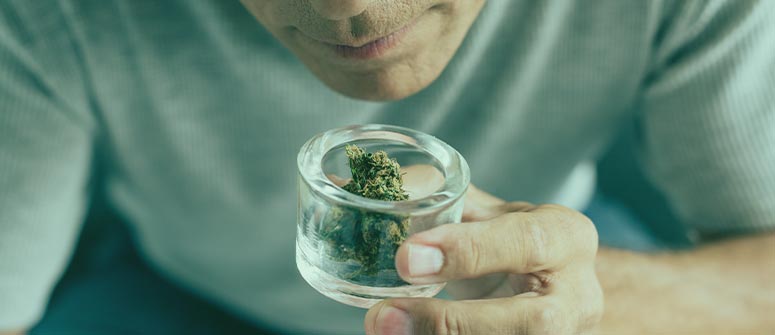
When shopping for cannabis seeds, online seed banks offer a lot of information. Yield is important, but many growers also look for overall quality, potency, and flavour as well. Here are some of the characteristics you are most likely to find listed on seed descriptions.
Yield
First, yield. This refers to the amount of dried bud you can expect to have after you’ve harvested, dried, and cured your crop. Indoor measurements usually range from 400–650g/m² for photoperiod plants, but they can easily go outside this range. Outdoors, it ranges from 400g/plant up to 2.5kg/plant for monster sativas. For autoflowering plants, indoor yields average at around 350–450g/m², with outdoor yields of around 80–250g/plant.
One potential point of confusion is the distinction between wet and dry harvest weight. Freshly harvested cannabis buds contain around ¾ more water than dried buds, which means the wet harvest weight will be significantly higher. As such, when seed banks present estimated yield ranges, it isn’t always clear which “type” of yield they’re referring to. Most high-quality seed banks, however, will provide yields based on dry harvest weight, as this is what you'll actually be smoking and storing.
Genetics and parents
Reputable seed banks should also provide the genetic makeup of each cultivar. This is usually expressed as something like “parent 1” x “parent 2”. For those who know a little about cannabis, knowing the parents and genetics of a strain can tell them a bit about what to expect from a seed. For example, a strain may be the result of breeding OG Kush x Bruce Banner 3.
Flowering time
Flowering time indicates how long a plant will take to mature (reach harvest) after entering the flowering stage. For photoperiod strains, the average flowering time for indica-dominant plants is around 8–10 weeks, and around 10–13 weeks for sativa-dominant specimens. Like most aspects of cannabis growing, many strains can exhibit flowering periods outside of this range.
For autoflowering cannabis seeds, seed banks will provide an entire seed-to-harvest date as opposed to only the flowering stage, as the vegetative stage of autos is predetermined in length. Given that most autoflowers veg for 3–4 weeks before entering flowering, it’s possible to give an indication of the overall time it will take to grow a specimen from beginning to end. For example, many autoflowering seeds are listed as having a total life cycle of 10–12 weeks, with 3–4 weeks weeks spent in veg and 6–8 weeks in flowering.
With photoperiod seeds, the veg phase can be extended or limited by the grower, which is why seed banks only list information about the flowering period.
Height
Overall plant height will also be advertised, often expressed as a range. Usually, an indoor and outdoor maximum will be given, as the space and light source can have a large impact on the finishing height of a plant. This is important, as many growers require plants that stay fairly small to fit comfortably into an indoor grow space. Indoor height can vary from just 60cm for tiny autoflowering plants to around 1.5m for more robust photoperiod specimens. Outdoors, anywhere up to 3m or more is possible depending on genetics!
Flowering type (photoperiod or autoflowering)
Whether a seed is photoperiod or autoflowering will also be displayed, as this is crucial when it comes to selecting and growing marijuana seeds. Autos tend to be much easier to grow, but offer less in terms of yield and potency. Photoperiods, on the other hand, can require significantly more effort, but offer a lot more in return.
Sex (regular or feminized seeds)
Cannabis seeds can be purchased in feminized or regular format. Feminized cannabis seeds will sprout into all female plants—those that produce smokable, cannabinoid-rich flowers. Regular seeds could become either male or female. Males don’t produce much in the way of cannabinoids and can pollinate female plants, reducing their yields. Therefore, regular cannabis seeds are only worth buying if you intend to breed from them.
Flavour and aroma
Depending on the extent to which a seed bank provides strain information, descriptions will also give insight into how the final product will taste and smell. Some even go as far as mentioning the dominant terpenes in the blend responsible for exhibiting these scents and tastes. You might see a strain described as having notes of fruit, skunky, diesel, cheese, chocolate, lemon, flowers, and more.
Effects and cannabinoid profile
Finally, the proposed effects of a given strain—how it makes you feel when you smoke, vape, or otherwise consume it—are provided to let users know what they’re in for. Whether the strain is dominant in THC, CBD, both cannabinoids, or other cannabinoids will largely dictate the effects, alongside the presence of terpenes and other cannabis phytochemicals. Cannabis strains can be described as euphoric, sedative, relaxing, uplifting, stoning, etc.
Note that strain type (indica vs sativa) is no longer believed to dictate the effects of a given cultivar.
Cannabis yield claims: What we know, and what we don't
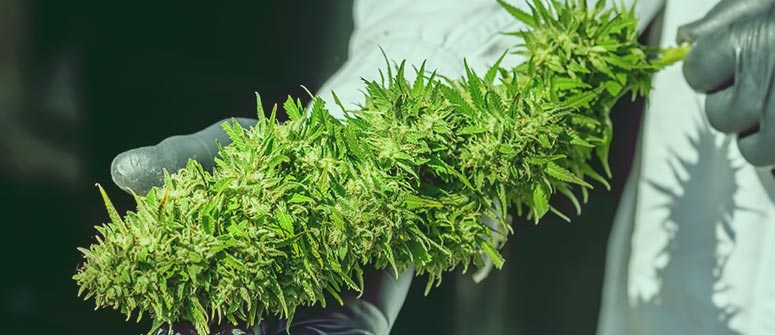
When it comes to figuring out what information yield claims are based on, there are certain factors we can assume, and others we just can’t know.
What we know
Though we can’t be sure, if we take a look around a cannabis seed bank’s website, we might be able to make a guess about the accuracy of their claims. If every single seed they sell offers out-of-this-world results, then we can probably assume the numbers are just made up for marketing purposes. If, however, they offer a range of products with specific yield information for each cultivar, then the claims are more likely to be accurate. You can always double-check them against similar strains on other seed banks too! Furthermore, you can browse growing forums for cannabis growers who have cultivated this specific strain, from this specific marijuana seed bank, to get a true indication for the dry harvest weight.
We also know that the figures are based on cannabis plants grown in near-perfect conditions, by experts. Therefore, even if the figures are true, it may not be the case that we can achieve them at home. We can assume indoor plants to be grown beneath 600–1000W lights and given top-tier care and fertiliser. Regarding outdoor numbers, we may not know where each cannabis plant was grown, but they’ve likely been based off the highest-performing specimens.
What we don’t know
We can’t know exactly how seed companies decide on their numbers. Do they grow many plants and take the average yield, or just the best? In many cases, it’s probably the latter. We also don’t know exactly how they’ve grown their plants, but they probably used some training techniques to maximise yields as much as possible.
We also can’t know if the numbers are from plants grown from seed, or from clones of the best phenotype (more on this below). And finally, we don’t know if seed banks use wet harvest or dry harvest weight for their yield figures.
Will I be able to achieve the yield listed on a strain description?
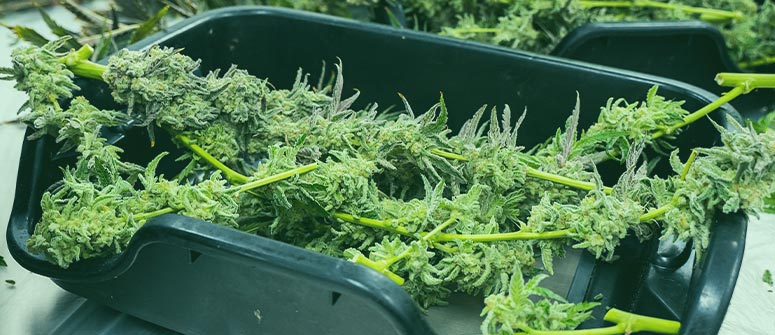
Potentially. If the numbers are based on real evidence, then experienced growers, growing in perfect conditions, can achieve those yields—or even more! Beginner growers should expect less, though. If the grow goes well, you can hope for between one-third and half of the advertised yield, which in most cases is still pretty massive.
Outdoor cannabis growers are very much at the mercy of the elements. Experienced growers could have bad luck and see a small harvest, whereas beginners could be blessed with a perfect season and haul in a monster harvest “by accident”. That being said, skill will still serve you very well both indoors and outdoors.
How to achieve the yield advertised by cannabis seed banks
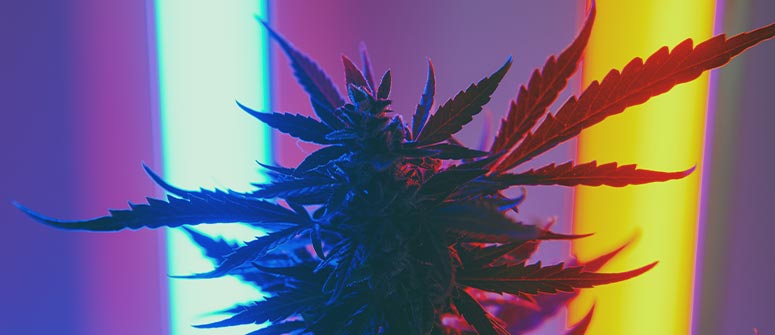
If you’ve bought some high-quality weed seeds and you think that the yields advertised are attainable, then there are certainly some practices you can employ to help you get close to them, or maybe even surpass them!
Indoors
Indoors, you’ve got to think in terms of metres squared. It’s not about how much each individual cannabis plant produces (as this can change depending on a few factors), but on how much bud is produced within the given space.
So, when growing in, say, one metre squared (1m²), it’s about efficiency. A few smaller plants will usually produce more compared to one big plant. Plus, it will be quicker, as the vegetative phase is most often shortened when growing a few small plants. The most simple version of this technique is called “sea of green” (SOG), and involves initiating bloom early and maintaining a low, even canopy—a sea of green!
Those looking to grow one or two larger plants in a small space, however, can use the “screen of green” (ScrOG) technique, which is a low-stress training method that involves weaving and tying developing cannabis branches to a horizontal mesh screen to maximise light exposure and the surface area of the canopy.
Using either of these methods, or other training methods, will inevitably increase your yields and get you closer to those advertised. Moreover, using 600W lights minimum will be important, as (to a degree) stronger lights mean greater yields.
Of course, general love and care is perhaps the most important factor in achieving large yields. Good feeding and watering, appropriate temperature and humidity, airflow, and pH level all play into the final yield. The more your plants struggle, the less energy they’ll have to devote to growing flowers. Therefore, nailing your growing skills is crucial to consistently bringing in large hauls.
Outdoors
Outdoors, matters are a little different, as yields are measured per plant. Remember, plants are likely to get pretty big. Given this, the key to outdoor growing is to expose your specimens to as much sun as possible and let them flourish to the best of their ability. The bigger they are, the more flowers they can produce.
There are some ways to help with this. Plants need space to grow. Very large pots, or even planting them straight into the ground, will give their roots plenty of space to spread out, leading to significant above-ground growth.
You could also begin growing your plants indoors to extend their overall life cycle. Outdoors, April or May tend to be the months when growing can begin in the Northern Hemisphere. But you could start your cannabis seeds indoors earlier, to give plants extra time to grow. They’ll start flowering at the end of summer regardless, so this just gives them more time to veg and gain size.
And, as with indoor growing, generally caring for them will help to achieve the best possible yields.
Note: growing in a greenhouse can achieve the best of both worlds, allowing growers a significant degree of control over environmental variables, while still harnessing the power of the sun.
Pheno hunting
Two important terms in cannabis cultivation are genotype and phenotype. Genotype refers to the genetic makeup of a plant, whereas phenotype refers to the expression of the genotype. Some cannabis strains are less stable than others, and so a single genotype can give rise to multiple phenotypes.
So, there will be some phenotypes (phenos) that display a higher yield than others, and you can’t be sure of what you’ll get when growing multiple seeds. Therefore, for experienced growers after the most insane yields, finding that perfect phenotype is a worthy mission. Perhaps the easiest way for most growers to go about pheno hunting is to grow many seeds, then choose the plant(s) with the most desirable traits (such as size and vigour). Then, many cuttings should be taken from these specimens, and clones should be grown.
Each of these clones will be identical to the mother plant, and therefore every single one will be capable of producing the desired traits for which it was picked!
Should you pick a cannabis strain based solely on its yield?
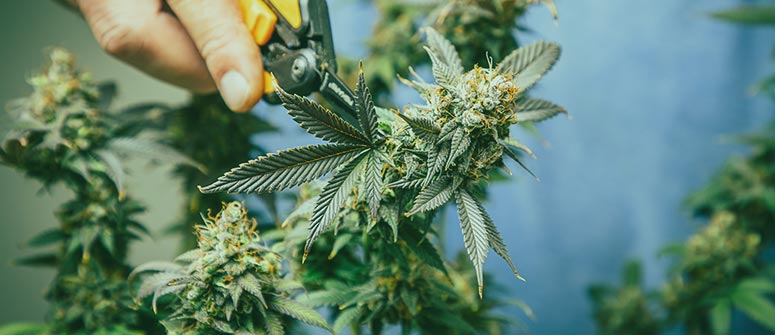
Certainly not! While everyone dreams of huge stashes of weed, there’s more to it than that. With a whole world of strains out there, each with its own cannabinoid ratio, terpene profile, and more, yield needn’t be everyone’s primary concern. What’s more, most modern strains offer pretty massive average yields anyway, so it’s best off to choose high-quality seeds with the overall qualities (flavour, effects, ease of growth) you’re after, as opposed to selecting a strain that displays huge yields, but underwhelms when it comes time to smoke.




